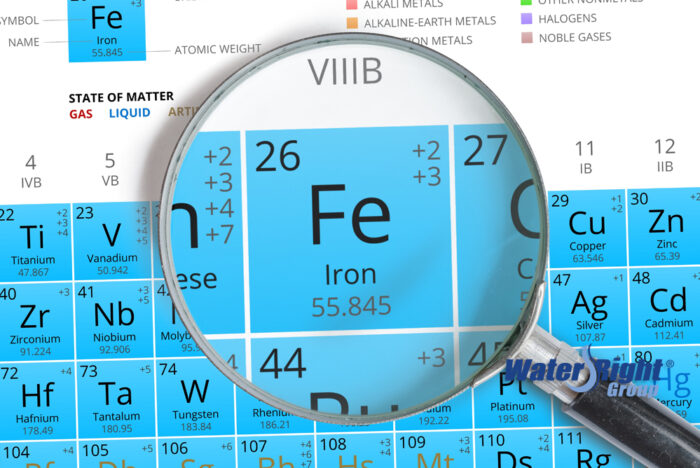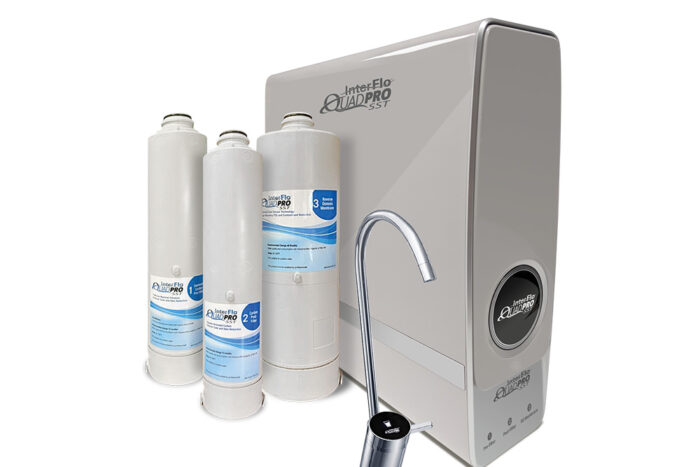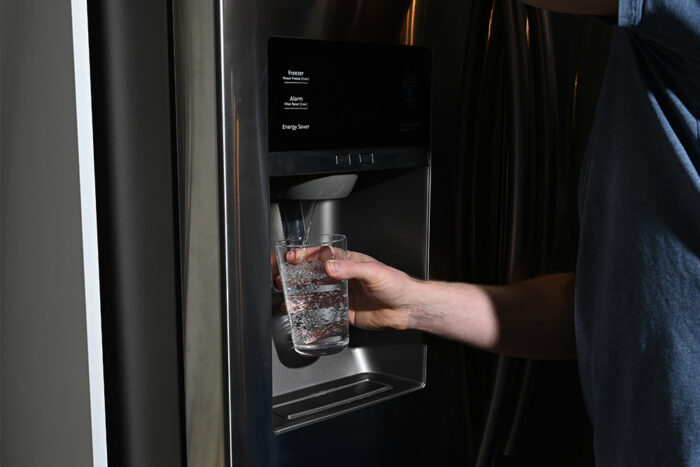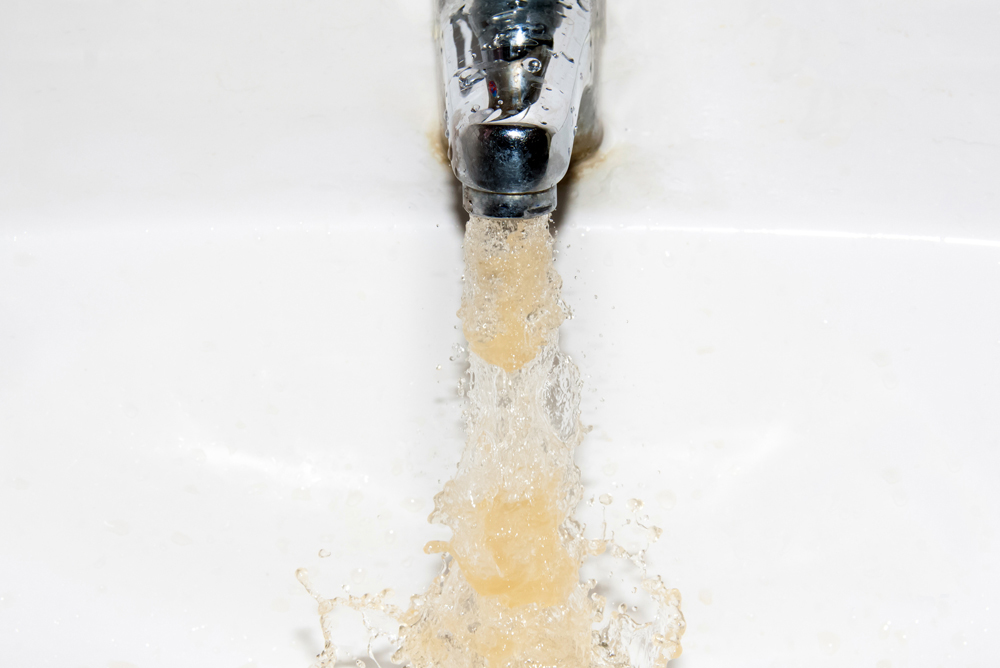Rusty, orange water coming out of your faucet is usually a dead giveaway that you’re dealing with high levels of iron in your water. However, you could also have iron that is practically invisible or appears as tiny flakes in your glass. Even the small amounts of “clear water” iron can leave rust stains on your sink and fixtures after the water dries.
While iron is not considered a contaminant with any harmful side effects to health, it certainly can have negative results on water quality. Beyond the unappealing appearance of your home’s water, iron can also cause other household headaches.
High iron makes drinking water, coffee, and teas taste metallic. Food cooked in water with iron may become discolored and have an odd flavor, too. Iron can leave unsightly stains on fabrics and fixtures such as sinks and toilets. Plus, it can lead to plumbing issues as it builds up inside your pipes, and even water treatment equipment can be gummed up by iron residue.
When it comes to our bodies iron is an important nutrient, but most people get 95 percent of the iron they need from food. Typical tap water in the United States only provides 5 percent of the FDA’s recommended daily value.
So, if iron is causing more issues than benefits, why not remove it from your home’s water?
Contrary to popular belief, a standard water softener isn’t enough to fix iron issues. Iron appears in water in different forms, and there are a variety of ways to improve quality using unique in-home water treatment solutions. Let’s take a closer look …
Insoluble Ferric Iron in Water (Fe+3)

Sometimes iron (Fe+3) is visible to the naked eye. This type of iron is insoluble, or does not dissolve in water, because it has been oxidized. So, if you’re seeing discoloration from what’s often described as “red-water iron,” it is ferric iron.
Ferric iron is also referred to as precipitated or colloidal because there are tiny particles of “iron dust” floating in the water. Ferric iron will likely cause staining and other issues, but a water treatment expert may be able to remove red-water iron using the right type of filtration media.
Greensand Plus™ is a common media used for iron filtration. However, this media needs to be recharged using potassium permanganate, which some homeowners wish to avoid for safety reasons because it is a caustic chemical.
Another option for iron filtration is a water treatment media made from a synthetic zeolite known as Crystal-Right®, which has a voracious appetite for removing both iron and manganese. Crystal-Right® can be an ideal media for homes getting water from a well.
Soluble Ferrous Iron in Water (Fe+2)
Ferrous iron (Fe+2) is the second type that is dissolved in water, and it cannot be seen – at least not at first.
Leave a glass containing what’s often called “clear water iron” out on the counter for a while and watch what happens. You will notice that tiny reddish particles are settling at the bottom of the glass. That’s because the ferrous iron is being exposed to oxygen in the air and turning into ferric iron.
Oxidation is a necessary step in treating water with dissolved iron so that there is a tangible particle for the media to filter out. While media like Greensand Plus contain oxygen that helps in the process, many times an iron filtration system with a dedicated air chamber is needed. This equipment injects air into the top of the tank to transform ferrous iron into particulates for removal.
Water-Right offers the Impression® Plus Series iron filters. These systems can also remove manganese and small amounts of sulfur, the latter of which causes that rotten egg smell in residential water.
As long as the iron stays dissolved and is never oxidized, it will not cause staining. However, you can still taste it just as you would be able to taste table salt that’s dissolved in water.
But as explained earlier, ferrous iron becomes ferric when exposed to oxygen. That’s why clear water iron that sits in a tub or toilet will eventually leave an orange ring. Iron levels as low as 0.3 parts per million can start causing stains. In other words, if 0.00003 percent of the water in your glass of water has iron in it, you can expect rust stains throughout your home!. That’s not very much!
You may be thinking you’ll just add bleach to your laundry to help keep them white, but bleach is an oxidizer that will also convert dissolved iron to particulates. That’s why some people notice water in the washing machine turning tan when bleach is added. The same can happen when adding chlorine to a swimming pool, and no one wants to swim in rusty-looking water.
Organically Bound Iron
Sometimes, iron combines with other material in groundwater to cause even more problems. Organically bound iron forms when the iron attaches to what are called tannins in the water.
Tannins are decomposed organic matter that come from leaves, tree roots, and other types of vegetation that dissolve and ferment in the groundwater supply – almost like a tea. Similar to iron, tannins pose no health risk, only aesthetic issues such as water discoloration, staining, and a musty flavor.
Positively charged iron ions are attracted to negatively charged organic matter and can bind to some tannins. This makes it more difficult to effectively remove dissolved iron without additional filtration.
To solve this problem, Water-Right offers the Impression® Plus Tannin Filter.
Iron Bacteria
This somewhat disgusting water quality issue isn’t as much a type of iron so much as a result of having iron in your home’s water.
Certain forms of bacteria feed off dissolved iron for energy. Iron bacteria isn’t harmful to human health, but the byproduct of its feasting is a brown, gelatinous slime created when it oxidizes clear water iron.
You may notice this gunk growing in the back of your toilet tank where it can leave stains and cause a foul odor. Iron bacteria can also build up on your well screen and in your appliances and plumbing.
The slime these microorganisms produce may even cause problems in your water softener. That’s one reason why Water-Right developed a pair of innovations that help disinfect water treatment systems. Our patented chlorine generator can prevent bacteria buildup in your water softener or Crystal-Right equipment, and our ozone generator is a chemical-free option that oxidizes and cleans air-injected filtration systems.
Take on and Take out Iron with Help from a Local Expert
Iron is the most abundant element on the planet, and it can be found in the earth’s crust, which means homeowners with wells often have groundwater quality issues related to iron. But, it can also leach from metal pipes in a home.
In most cases, fixing high iron water is not a DIY project in which you can simply install a water softener you bought at a big box store. You need a local expert who understands water quality in your region and can recommend the right methods of filtration based on an official analysis.
When you’re ready to stop scrubbing iron stains and get the kind of water quality your family deserves, turn to trustworthy specialists with the knowledge and the equipment to provide a solution.
Find the right contractor for you.
Recent Homeowner Resources

Are You Drinking Contaminated Water? New Rules Help Homeowners Identify Lead Risks

Introducing InterFlo® QuadPro SST!



